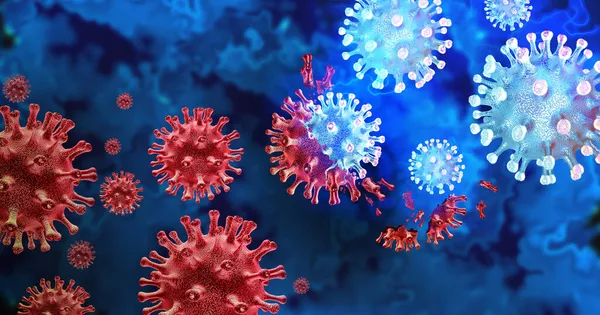Omicron variants evade immune defenses like predecessors, suggesting a key adaptation in SARS-CoV-2 evolution. – A study has shown that Omicron variants of SARS-CoV-2 increase innate immune evasion, suggesting that the earliest host innate immune responses are crucial in SARS-CoV-2 transmission
The study examined the evolution of SARS-CoV-2 variants, specifically the BA.4 sub-VOC and the BA.5 sub-VOC, which suppress innate immunity more than their predecessors
The findings indicate that Omicron sub-VOCs have developed mutations beyond the spike protein, suggesting S-independent adaptations potentially crucial for SARS-CoV-2 Omicron dominance.
Key points from the study include:
- Omicron sub-VOCs have synonymous and non-synonymous mutations in ORF6 and N, but no mutations distinguish the BA.4 sub-VOC and BA.5 sub-VOC from BA.1 sub-VOC and BA.2 sub-VOC, indicating they have evolved independent mechanisms to increase ORF6 and N protein levels or by ORF6 expression being the primary determinant of enhanced innate immune antagonism in emerging VOCs.
- All Omicron subvariants triggered significantly less IFNB and CXCL10 expression than BA.2 at 24 hours, indicating that the earliest host innate immune responses are crucial in SARS-CoV-2 transmission.
- Viruses with enhanced ability to evade or antagonize innate immunity, such as increased ORF6 and N expression, transmit more frequently due to their ability to avoid inducing or shutting down.
The study highlights the importance of understanding the evolution of SARS-CoV-2 variants and their ability to evade the immune system, as this knowledge can inform the development of more effective vaccines and treatments.
What is the ba.4 sub-voc and ba.5 sub-voc
BA.4 sub-VOC and BA.5 sub-VOC are sub-lineages of the Omicron variant of SARS-CoV-2. These sub-lineages emerged with more than 30 mutations in their viral spike proteins, allowing them to have more transmissibility and infection rates than their predecessors
According to a study, BA.4 and BA.5 sub-VOCs suppress innate immunity more than earlier subvariants, and they have evolved independent mechanisms to increase ORF6 and N protein levels or by ORF6 expression being the primary determinant of enhanced innate immune antagonism in emerging VOCs
BA.5 sub-VOC has a more significant entry into transmembrane serine protease 2 (TMPRSS2)-lacking cells than prior subvariants, but Calu-3 cell entry was TMPRSS2-dependent, resulting in cell-specific discrepancies in VOC titers.
How does sars-cov-2 evade the immune system
SARS-CoV-2 evades the immune system through various strategies, as highlighted in several studies. Some of the immune evasion mechanisms employed by SARS-CoV-2 include:
Spike protein camouflage: The virus uses glycan molecules to mask epitopes on the spike protein, making it harder for the immune system to recognize and neutralize the virus.
Impairment of antigen presentation: SARS-CoV-2 variants can impair the presentation of viral antigens by major histocompatibility complex class I (MHC-I), reducing their recognition by the immune system.
Inhibition of interferon synthesis: The virus can inhibit the production of interferons, which are key signaling proteins in the immune response to viral infections.
Mitochondrial sabotage: SARS-CoV-2 can cause mitochondrial dysfunction, leading to the production of reactive oxygen species (ROS) and evasion of apoptosis in infected cells. These strategies allow the virus to escape recognition and destruction by the immune system, contributing to its ability to cause persistent infections and evade immune responses, including those induced by vaccines.
Study key findings:
- BA.4 and BA.5 suppressed innate immune responses more effectively than earlier Omicron sub-variants.
- Increased expression of viral proteins ORF6 and nucleocapsid, particularly in BA.5, correlated with this immune evasion.
- ORF6 specifically suppressed host defenses by reducing immune signaling pathways.
- Omicron, especially BA.5, showed increased entry into cells lacking a specific protease (TMPRSS2), differing from Delta.
- Calu-3 airway cells infected with BA.4 and BA.5 triggered lower immune activation compared to BA.1 and BA.2.
- Omicron sub-variants overall induced significantly lower interferon and immune gene expression than BA.2. Study source
ALSO READ: Long COVID: Study Uncovers Immune Dysregulation in Patients








